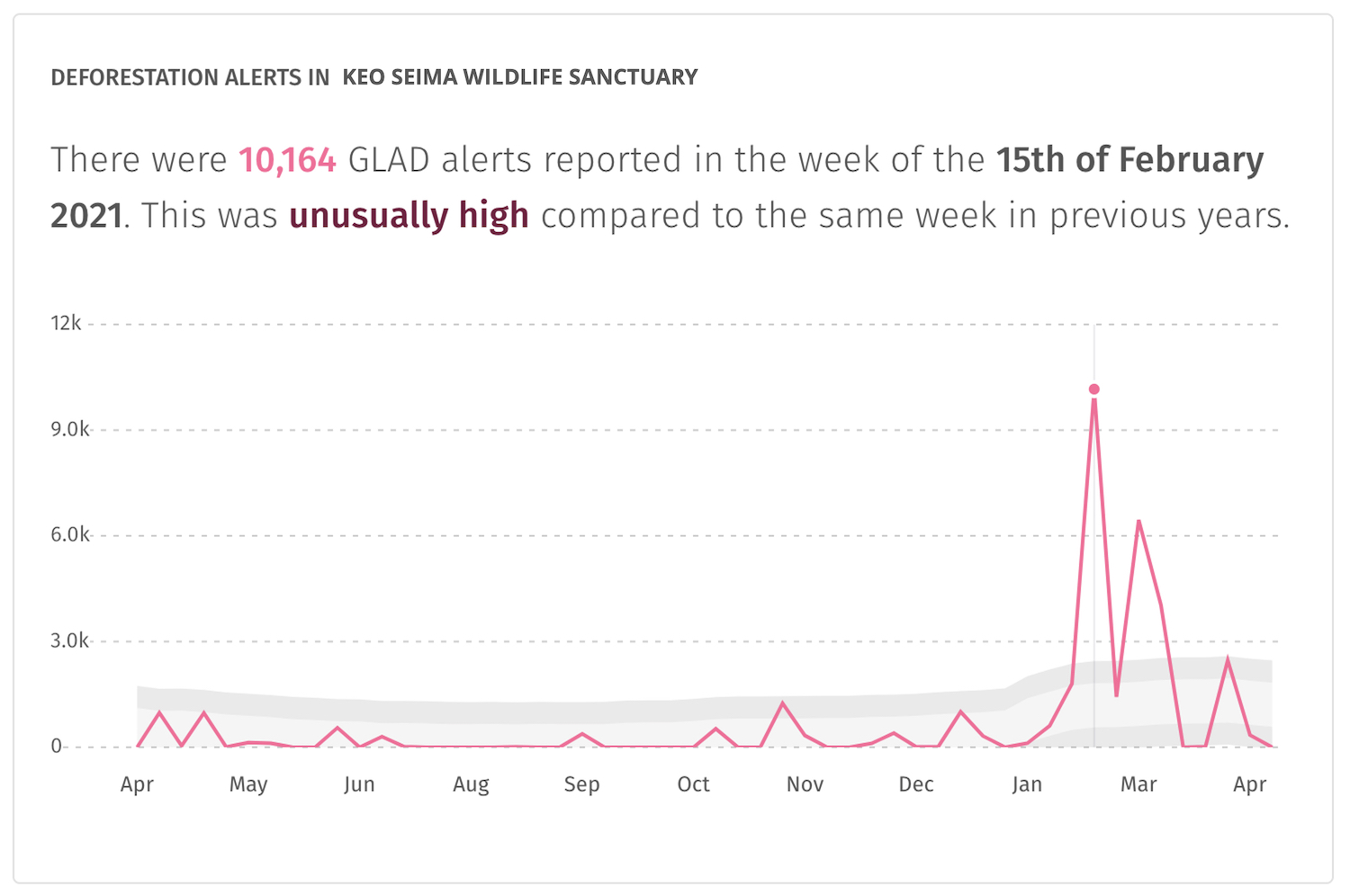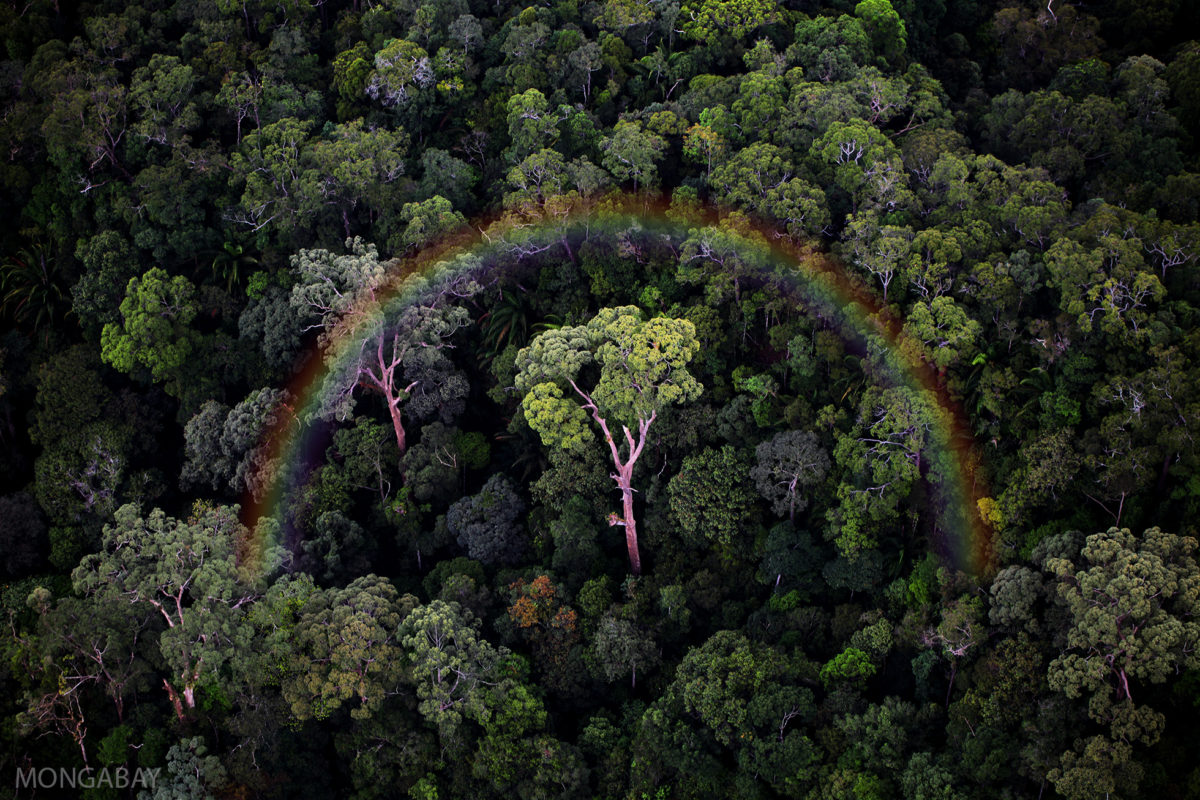- The forests of Keo Seima Wildlife Sanctuary boast a plethora of wildlife – including several endangered and recently described species.
- But the habitat these animals depend on is disappearing, with 32% of Keo Seima’s primary forest cleared over past 20 years.
- Recent satellite data suggest 2021 is not starting out well for Keo Seima, with higher numbers of deforestation alerts detected than in years past.
- Major drivers of forest loss in Keo Seima include illegal logging and agriculture.
Keo Seima Wildlife Sanctuary sprawls across a vast expanse of Cambodia’s eastern reach. But much of what used to be covered in lush rainforest has been laid barren by deforestation. Now, satellite data are showing several recent incursions into the sanctuary’s last tracts of primary forest, which provides vital habitat for wildlife – including several endangered species.
Encompassing some 300,000 hectares (3,000 square kilometers/1,160 square miles), Keo Seima contains a dizzying array of animals and plants. The protected area is home to more bird species than any other in Cambodia, with 350 documented so far. Around a quarter of the country’s remaining endangered Asian elephants (Elephas maximus) are found here, as is the world’s largest known population of critically endangered black-shanked douc langurs (Pygathrix nigripes). In total, researchers have documented 75 threatened species in Keo Seima, and at least 15 species new to science have been discovered over the last 20 years.

To help safeguard this biodiversity, the Cambodian government enacted protection of the area in 2002. Keo Seima’s initial incarnation was as Seima Biodiversity Conservation Area, after which it became Seima Protection Forest in 2009 before being redesignated yet again as a wildlife sanctuary in 2016. However, it appears official protection has not been able to stave off the onslaught of deforestation that has stripped Keo Seima of much of its forest cover.
According to satellite data from the University of Maryland (UMD) visualized on forest monitoring platform Global Forest Watch, Keo Seima lost 32% of its primary forest between 2002 and 2020, with most of this loss occurring after 2011. While the biggest spike occurred in 2013/14 before tapering down in 2015, UMD data indicate the sanctuary’s deforestation rate is once again on the rise, with primary forest loss in 2019 doubling over 2018 – and 2020 higher still.

Preliminary data from UMD’s Global Land Analysis and Discovery (GLAD) lab suggest Keo Seima’s forests may be in for another rocky year in 2021, with “unusually high” numbers of deforestation alerts – more than triple the average of years past – detected in February, March and April. Satellite imagery shows clearings spreading into areas that had previously been undisturbed.

Reporting by Mongabay in 2020 found that much of the deforestation in Keo Seima has been driven by illegal logging, with many of the logged trees destined for timber markets in Vietnam. Sources say forests are also being cleared to make room for crop fields and plantations.
“There is still a steady stream of timber from Seima protected area across the border into Vietnam,” Cambodian forest expert Marcus Hardtke told Mongabay in August 2020. “It is more diverse now, often at night, but it continues. And it almost always involves people in uniform at several levels. It’s a balanced system of bribes and influence. If this balance is disturbed, violence can occur.”
The situation came to a head in early 2018 when military police officer Seng Vattana, forest protection ranger Tern Soknai and Wildlife Conservation Society GIS officer Thol Kna were shot and killed after confronting illegal loggers and confiscating equipment.

Keo Seima is also home to many Indigenous communities, the majority of which belong to the Bunong ethnic group. The government has introduced legislation designed to award land titles to those living inside the boundaries of the wildlife sanctuary, but local sources say this is often used by land grabbers to establish legally legitimate claims to protected land.
“The apparent aims of these legislative acts are noble, and something on paper we support – ensuring legal recognition of traditionally owned lands, especially for indigenous [Bunong] people,” said a staff member of a conservation organization working in the area who spoke to Mongabay in 2020 on the condition of anonymity. “But the reality of its implementation is that land has, and likely will, be given to anyone who can establish a veneer of legitimacy to a claim of historical use. We strongly support legal titles for indigenous communities, and this has and continues to be a major part of our work in Keo Seima.”
Banner image: Sunlight filters through forest in Keo Seima Wildlife Sanctuary. Image by user Pygathrix nigripes via Wikimedia Commons (CC BY-SA 4.0).
Editor’s note: This story was powered by Places to Watch, a Global Forest Watch (GFW) initiative designed to quickly identify concerning forest loss around the world and catalyze further investigation of these areas. Places to Watch draws on a combination of near-real-time satellite data, automated algorithms and field intelligence to identify new areas on a monthly basis. In partnership with Mongabay, GFW is supporting data-driven journalism by providing data and maps generated by Places to Watch. Mongabay maintains complete editorial independence over the stories reported using this data.
Feedback: Use this form to send a message to the editor of this post. If you want to post a public comment, you can do that at the bottom of the page.









![Wild male saiga antelope (Saiga tatarica) visiting a waterhole at the Stepnoi Sanctuary, Astrakhan Oblast, Russia. Photo credit: Andrey Giljov [CC BY-SA 4.0]](https://imgs.mongabay.com/wp-content/uploads/sites/20/2019/08/16183224/Saiga_antelope_at_the_Stepnoi_Sanctuary-768x512.jpg)




